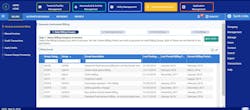Melissa Garza-Perry, airports properties manager for the city of Fresno Aviation Department in Fresno, Calif., said they recently upgraded to the GCR ABRM software, which takes the system from a server-based system to a web-based system.
“We started preparing for this back in October,” she said. “We started testing probably back in September because we went from an Oracle-based system to a sequel server and now we’re on cloud. We had to be able to move our information, which they did, but we had to test the different backgrounds to make sure all the information was coming over properly.”
Garza-Perry said Fresno decided to switch to a cloud-based system because of storage space issues and it allowed the airport to get away from the city of Fresno ISD division and relying on them for servers.
“All of our documentation is electronic, so keeping everything electronic and having the storage for it, having 14 years worth of it, at this point was just too much,” she said.
Fresno staff sat down and looked at different options to address this issue. Garza-Perry said the discussed ideas like hosting it themselves or going a partial cloud-based system compared to going to a full cloud-based system. Working through all the pros and cons of the systems, she said they decided the full cloud-based system was best for the airport.
“Keep in mind, it’s not going to be the same as before and you have to adapt to the new,” she said. “Once you adapt to the new, it’s amazing. It’s a whole new environment that gives you a lot more that you didn’t realize you needed.
Garza-Perry said they tested everything from the daily operations to the monthly and more minuet operations to make sure everything was working properly across the new system.
“Make note of what you do that’s not day to day, like your annual reports for testing,” she said. “Sometimes it’s the little things that get missed, so make notes of everything that you do with the system that will help you with testing if you decide to go to a new system.”
Know when to upgrade
Spencer Stewart, director of sales, aviation, for GCR Inc., said when municipalities decide to upgrade an ERP system like Oracle or SAP, they don’t come with a revenue management system specific enough for airports.
“They only find that out two to four years later when they’ve missed rent escalations, they’ve missed percentage rents, they’ve certainly missed and made a mess of landings and take offs and passenger facility charge tracking,” he said.
Stewart said the current condition of technology means everyone expects a quality user interface and user experience. If a system feels old and clunky the younger employees in the airport using those systems don’t have patience for the programs and then opt for alternative methods of data tracking like Excel.
“When that happens it’s the beginning of the end for that piece of software,” he said.
Arpit Malaviya, CEO of ProDIGIQ Inc., said there are few good aviation specific products to handle all aspects of revenue management at airports. The latest technologies automate the payment collection, to a great extent, at the same time bringing all aspects of revenue management whether concessions, operations and maintenance together through mobile usage in mind.
“The gains are phenomenal,” he said. “There is substantial cost saving in administrative and operations cost to run the airport business. Furthermore, there is additional benefit of customer service offered to external stakeholders and tenants through a good revenue management software.”
Marva Thomas, insurance manager at John Wayne Airport said they had a system they always used for property management agreement requirement tracking and insurance compliance tracking. There was another system that handled accounting and finance so they decided to get a new program that would integrate all the information.
“Something that would not just share the data, but pull up reports that instead of having to manually do reports for each other on demand, that it would empower users to be able to pull up their own data and if they wanted a report, to run their own report,” she said.
Thomas said they also wanted a system that was user-friendly and allowed them to have correspondence embedded in the system so they could identify groups of people who would need reminders for certain dates and items and send them the letters.
They also wanted to have the ability to eventually have concessions report to the airport to give leaders immediate information about revenue.
Thomas said the drive for a new system was driven internally at John Wayne. The airport’s finance department was content with the old system, but they needed something to take them off the hook with ad hoc reports.
“There was a delay in data passing back and forth between our property management department and our finance department,” she said. “Plus, properties, they were doing a lot more investigations into building up and enhancing our concessions, so it all evolved over the past two years where properties stepped up and said ‘gee, if we had this kind of data, there’s a lot more we could do in terms of anticipating what we need going forward in terms of revenue.”
Since implementation began, Thomas said they’ve seen efficiencies appearing across. They’ve saved time in insurance compliance time and it created efficiencies for the property management department by having all of their documents online in one place for easy reference.
Even for management, there’s a lot of reports on monitoring and auditing capabilities while accounts receivable staff no longer has to manually perform data entry.
“The final piece of the puzzle and another reason we were interested in a new and advanced system is this tenant portal,” she said. “We can get real time sales and other revenue information. That’s still on the planning board.”
Thomas said she utilized her knowledge of needs for John Wayne and talked with the finance department to find out their needs. It took about one year to get all the necessary information and send it out to get a vendor.
Implementation has taken another year, because Thomas said it has been done in stages. They started with the insurance department, then the properties department and then the finance department. Finance has a heavy workload so Thomas said they had to pick a time to get them involved and learning a new system, then entering the data.
Entry of data is the biggest investment in a switch, which was compounded when John Wayne decided to enter it manually into the new system.
“I chose to have us do it manually,” she said. “My purpose was that our existing system had some old data, incorrect data and I don’t believe in cluttering up a brand-new shiny system with old data. It was actually an opportunity for us to reroute things, to not include things that should have been deleted a long time ago and clean up the data.”
Malaviya said medium to large hub airports should allow at least 12 month lead time before they need to finalize the budgets. For small hubs and non-hubs, six month period is sufficient.
Airports should do both internal and external research in finding the new software. The internal research should provide clarity on the existing gaps and the source of the gaps. The gaps could be due to system limitations or lack of training. The external research includes interviewing other similar airports and understanding lessons learned.
“They should share the existing gaps with the potential vendors and try to get a sense of their capabilities in bridging those gaps,” Malviya said. “The airports should also ask about additional features that vendors can bring to the table to improve the airport’s business. These could be features and capabilities that the airport didn’t think of.
“The airports should also pay close attention to the vendors offering beyond revenue management software as the world is moving towards integrated solutions, Lastly, airports should evaluate the vendors on their aviation expertise.”
Head to the cloud
Stewart said airports are finally starting to adopt web-based systems compared to served-based. They’re now willing to entertain a subscription service, which helps developers as well.
“It’s so much harder to support an on premises installation now that we actually discount our hosted option below our on premises option,” he said.
A SAS system can also assist in security. If an airport is hit with an ransomware attack, it can prevent the airport from losing everything. Data backups are done nightly and stored offsite.
“Airports need to gain a good understanding of the current bottlenecks and how they could potentially be solved with a cloud solution,” Malaviya said. “Also, they need to be aware of any impacts or changes in the system usage in a cloud environment and consider improving their processes, if relevant. Lastly, they need to be ready to provide historical data for migration into the new platform.”
Fresno went to its city attorney’s office to discuss issues related to a switch from a server to a cloud system. With all of the background the supplier had with government entities and how they handled their backups, gave leaders assurance they would be OK switching to the new system, Garza-Perry said.
“If I’m working from home, I don’t have to VPN into my system here,” she said. “I can log in and not have that VPN dely.”
Fresno switch to web-based in April and Garza-Perry said it has been a very smooth rollout of the system, with only a few minor issues. The look and data entry operations are a little bit different than the old system, but she said there has been no major issues.
Thomas said John Wayne opted for a cloud-based system, taking them off internal servers as it offered more flexibility. The internal server also provided endless connection issues.
“Going to a cloud-based system, we’ve not had any of those problems,” she said. “We have enough firewalls and other protections that I think we’re good.”
“The people who work for them, they’re the line workers,” he said. “They’re the people who cut the checks, receive the invoices and hear the tenant complaints.”
Thomas said she knew most of the needs for John Wayne before opting for new software, but went to other departments before creating a full goal and need.
“Be inclusive in the planning process,” she said. “If you intend more than one working unit to use this system, then you must involve the other user departments in building the specifications. Otherwise you’re going to leave somebody out, leave a piece missing and it’s not going to ultimately meet everyone’s needs.”
About the Author
Joe Petrie
Editor & Chief
Joe Petrie is the Editorial Director for the Endeavor Aviation Group.
Joe has spent the past 20 years writing about the most cutting-edge topics related to transportation and policy in a variety of sectors with an emphasis on transportation issues for the past 15 years.
Contact: Joe Petrie
Editor & Chief | Airport Business
+1-920-568-8399
>> To download the AviationPros media kits, visit: Marketing Resource Center
>>Check out our aviation magazines: Ground Support Worldwide | Airport Business | Aircraft Maintenance Technology

